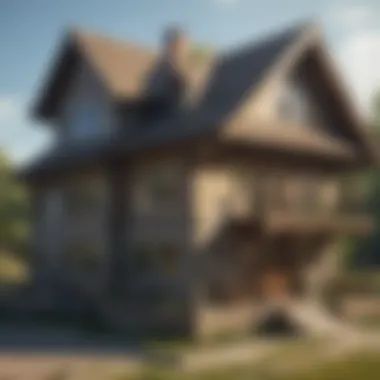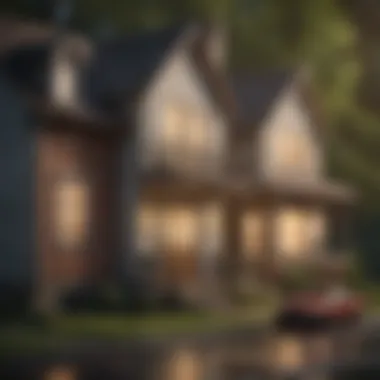Understanding Dwelling Coverage in Homeowners Insurance


Intro
In the realm of homeowners insurance, the concept of dwelling coverage often gets tossed around without a proper understanding of what it encompasses. It's not just about having a policy in place; it’s about ensuring that your home—the very shelter that protects you and your family—is covered when life's unexpected occurrences happen. Dwelling coverage is that safeguard against an array of risks that can threaten the structure and integral systems of a home, providing peace of mind to homeowners.
A house isn’t merely a collection of walls and a roof; it’s a sanctuary filled with memories and, for many, it's also the most significant financial investment they'll ever make. Understanding what dwelling coverage includes is critical for homeownership, equipping you with the knowledge needed to navigate the insurance landscape wisely. By comprehending the various components involved—ranging from specific materials to the structural aspects—you’ll be better prepared to make informed decisions about protecting your property.
This article will break down the aspects of dwelling coverage, highlighting not only what it protects but also the nuances and specifics that homeowners ought to be familiar with. By the end of this guide, you'll have a solid grasp of how to shield your home effectively, ensuring that you're not left in the lurch when disaster strikes.
Understanding the Concept of Dwelling Coverage
When it comes to home ownership, understanding dwelling coverage is an essential puzzle piece. This segment of homeowners insurance looks not just at a roof over your head, but the structure behind it and what keeps it standing tall. Homeowners often invest a significant amount of their wealth into their property, so comprehending how dwelling coverage functions can save a lot of headaches down the line. Knowing what is included and what the limitations are can make all the difference, providing a safety net in uncertain times.
Defining Dwelling Coverage
Dwelling coverage refers to the portion of a homeowners insurance policy that safeguards the physical structure of a home from various risks. This coverage typically includes the primary residence's walls, roof, and any attached structures like garages. Think of it as a shield; when unexpected hits like natural disasters or accidents occur, this coverage steps in to address repair costs. For instance, if a hailstorm washes over your area and damages your shingles, dwelling coverage might cover the repair or replacement of that roof.
However, it’s not merely about replacing or fixing walls and shingles after the fact. The definition is far broader, including built-in components such as heating systems, air conditioning units, and even plumbing fixtures. The core idea remains: if it’s a permanent part of your home’s structure, it’s likely included in this coverage.
Purpose of Dwelling Coverage
The purpose of dwelling coverage is straightforward yet vital: it's there to protect your most significant investment, your home. Just like any good financial plan, protecting what you own is half the battle. The intent is to cover costs related to repairing or replacing parts of the home that suffer damages, ensuring homeowners don’t have to face hefty bills that could deplete savings in a matter of minutes.
For many people, their home is both a sanctuary and an investment. Consider these points that outline the purpose:
- Financial Security: By covering the replacement costs, this type of insurance provides a financial buffer, allowing homeowners to rebuild or restore without catastrophic losses.
- Peace of Mind: Knowing you’re covered can ease the mind, especially in unpredictable times. Fewer worries translate into a better quality of life.
- Compliance with Lenders: Often, mortgage lenders require homeowners to maintain specific coverage levels, ensuring their investments are also protected.
In short, dwelling coverage isn’t just a necessity for homeowners; it’s a key factor in managing overall financial health. It mitigates risks associated with homeownership and, consequently, promotes a sense of stability. Understanding this concept lays the groundwork for more specific aspects of dwelling coverage, as explored in later sections.
Key Components of Dwelling Coverage
Understanding dwelling coverage requires a keen grasp of its key components. This part of the article is crucial, as it dives into the specific elements that make up dwelling coverage. Knowing what these components are can help homeowners appreciate the breadth of protection their insurance provides and discern its utility in various scenarios.
Structural Coverage
Walls and Roof
The walls and roof of a home form its fundamental structure. They act not just as barriers against the elements but also contribute to the home's overall integrity. If a calamity occurs, like severe storms or vandalism, the insurance coverage for walls and roofs can save homeowners from significant financial blow. One standout characteristic of these elements is that they are often the most expensive to repair or replace. Insurance typically covers damage to them, whether from a fallen tree or a fire, making it a crucial aspect of dwelling coverage.
Also, it's worth noting that the materials used in roofing and walls, such as tiles or shingles, can influence how insurance views a damage claim. In areas known for severe weather, metal roofs may lower premiums due to their durability, making them a popular choice for many homeowners.
Foundation and Basement
The foundation is the unsung hero of a building, providing the base for everything above it. A solid foundation ensures the home remains stable and resistant to various pressures. Insurance policies typically protect against damages stemming from natural disasters, floods, and other risks that may affect a home’s foundation and basement.
Homes with basements present unique characteristics and challenges. They may have mold or flooding issues that can complicate claims. Homeowners should always check what their policy covers regarding these areas, as it varies significantly across different insurance plans.
Porches and Decks
Porches and decks are more than just aesthetic add-ons; they serve as critical spaces for relaxation and socializing. Damage to these areas can occur from storms or improper maintenance. They are often included under dwelling coverage, a key characteristic that makes insurance policies suitable for homeowners valuing outdoor spaces.
One unique feature of porches and decks is their exposure to weather conditions, which can lead to rot or structural failure over time. This risk can influence insurance premiums, encouraging regular maintenance and inspections for long-lasting performance.
Attached Structures
Garages
Garages provide both utility and security, often safeguarding vehicles from extreme conditions. They also can serve as additional storage space or a workshop for the homeowners. As part of dwelling coverage, damage to a garage due to accidents, vandalism, or certain natural disasters is typically covered.


The key characteristic of garages is that they often come attached to the home. This integration can lead to implications concerning fire safety codes and structural integrity. It's important for homeowners to understand how attached structures can impact their overall insurance policy terms.
Sunrooms
A sunroom, with its open layout and ample light, can provide a delightful extension to a home. Insurance coverage for sunrooms can vary, as they might be considered a separate structure depending on the material used or whether it is fully enclosed. A critical aspect of sunrooms is their potential for damage due to storms or extreme weather.
Unique to sunrooms is their ability to enhance a home's market appeal. However, homeowners should be mindful of any limitations their insurance policy may impose on this aspect, particularly if significant renovation or rebuilding is required.
Carports
Carports serve a specific purpose in residential areas: protecting vehicles without the full investment of a garage. They can be essential in areas with harsh winters or heavy rain. Like garages, carports typically enjoy the same dwelling coverage provisions, meaning damages from weather or accidents are often covered.
A unique feature of carports is their open design, which can sometimes make them susceptible to wind damage. This aspect could influence the decision to include additional coverage, depending on the location.
Built-in Appliances
Heating and Cooling Systems
Heating and cooling systems are the backbone of a comfortable living environment. They're often integrated into a home in ways that make them crucial for overall functionality. Most dwelling coverage policies include protections against damages stemming from breakdowns or environmental factors affecting these systems.
One standout characteristic is that they are usually expensive systems to install or replace. Homeowners should be aware, though, that certain incidents, like flood damage, may not always be covered, which underscores the importance of reading policy details thoroughly.
Kitchen Appliances
In the heart of a home, kitchen appliances, from ovens to dishwashers, play a significant role. These items are usually covered by dwelling policies. Their key convenience lies in their integral nature—without them, everyday chores can become quite challenging.
What's unique about kitchen appliances is their tendency to malfunction, which can lead to costly repairs. Thus, understanding how each item is categorized under insurance can help streamline any claims process.
Water Heaters
Water heaters are often overlooked until a leak or breakdown occurs. They provide hot water for various household activities: bathing, cleaning, and cooking. Coverage for such systems may come under dwelling policies, protecting against sudden breakdowns or damages due to external factors.
Unique features include their potential lifespan. Depending on the model and usage, they can last over a decade, so adequate coverage ensures that you won't face significant out-of-pocket expenses down the line.
Additional Structures Coverage
When considering home insurance, Additional Structures Coverage often gets overshadowed by dwelling coverage itself. Yet, understanding this aspect is crucial for homeowners looking to protect their investments fully. Additional structures encompass various outdoor installations that could be susceptible to damage, and recognizing their significance can prevent financial headaches down the line.
This type of coverage extends protection beyond the structure of the house, covering buildings or structures that are not attached to the primary dwelling. It includes items like fences, sheds, gazebos, and even detached garages. While they might not be the heart of a property, these structures can hold considerable value. Therefore, knowing what qualifies, as well as the limitations of this coverage, is essential.
What Qualifies as Additional Structures
Additional structures typically include a range of assets that might not be immediately apparent as part of a standard homeowners insurance policy. Common examples include:
- Detached Garages - Often used for vehicles, these can be targets for weather damage or vandalism.
- Sheds - These storage areas often house tools or outdoor equipment that, while not part of the main structure, still have financial value.
- Fences - An important boundary element that not only ensures privacy but can also be a costly repair if aged or damaged.
- Decks and Patios - Not always attached directly to the house, these areas can face wear and tear from the elements.
- Driveways - Though often overlooked, damage from extreme weather can undermine their integrity and safety.
Understanding these examples can help homeowners take the necessary steps to ensure they are adequately covered. If these structures were to suffer damage from a covered event, knowing they aren’t left high and dry due to the policy's nuances is a boon for any prudent homeowner.
Limitations on Additional Structures
While Additional Structures Coverage can provide a layer of financial protection, there are caveats worth noting. For one, not every structure may qualify. Here are a few limitations:
- Coverage Limits - Homeowners policies often have specific dollar caps on how much coverage is available for additional structures. This means that if costs exceed the limit, the homeowner is on the hook for the excess.
- Exclusions - Certain types of damage may not be covered, such as those from neglect or maintenance issues. For example, if a shed’s roof collapses due to lack of upkeep, that might not be covered.
- Variations by Insurers - Different insurance companies have their own definitions and standards. It’s prudent to read the fine print or clarify directly with the provider to avoid surprises.
In summary, while Additional Structures Coverage is a valuable component of homeowners insurance, understanding its scope and limitations is equally vital. As with all aspects of insurance, a proactive approach in comprehending these features can result in better protection and fewer disputes in the unfortunate event of a damage claim.
Natural Disasters and Coverage
When it comes to homeowners insurance, the significance of natural disasters and their coverage cannot be overstated. Understanding how these events impact dwelling coverage is crucial for homeowners. Natural disasters, by their very nature, are unpredictable and can wreak havoc on property. As a homeowner, knowing what is and isn't covered in your policy can save you from financial turmoil during some of life’s most challenging moments.


Fire and Smoke Damage
Fire poses a constant threat to homes, whether from unexpected electrical failures, wildfires, or in-home accidents. Fire and smoke damage is typically included in dwelling coverage policies, but there are nuances. For instance, while the damage caused directly by flames is covered, the aftermath from smoke can create additional complexities. Homeowners often overlook smoke damage until it manifests in unexpected ways—like lingering odors or discoloration. Furthermore, items within the home, like furniture and personal possessions, might require separate policies to fully safeguard against fire damage. Always review specific terms in your policy because the devil is in the details—certain restrictions may apply, such as deductibles or limits on repairs.
Wind and Hail Damage
Next on the list is wind and hail damage, which varies widely depending on your geographical location. Areas prone to storms might have stricter regulations regarding wind damage coverage. Often, homeowners find that their policies cover various forms of wind damage from tornadoes and hurricanes, but exclusions for certain amounts can exist. It’s crucial to take a good look at how your policy defines wind damage.
Heavy hail can lead to significant roof issues, cracked windows, and other structural concerns. To make matters more complicated, some insurers might apply different deductibles based on the type and magnitude of the storm. Understanding these details can help ensure that you are adequately prepared for potential repairs after a storm rattles your neighborhood.
Earthquake and Flood Considerations
Earthquake and flood considerations represent areas of dwelling coverage where many homeowners encounter gaps. Standard homeowners insurance policies often exclude these types of natural disasters by default. For many regions, flooding isn’t covered unless you have specific flood insurance, which is distinct from typical dwelling coverage. The National Flood Insurance Program can provide further insights on its specific policies.
Similarly, earthquake coverage is often considered an add-on or a separate policy altogether. This can leave a homeowner vulnerable if they live in an area with a high frequency of seismic activity. It's strongly recommended that you assess your property’s risk and consider acquiring these supplements if applicable. In addition to understanding exclusions, researching local insurance offerings can help you navigate the coverage options that exist for these natural disasters.
Key Takeaway: Always discuss specific coverage needs with your insurance agent. They can clarify intricate details that could significantly impact your financial wellbeing when natural disasters strike.
In summary, whether it’s fire, wind, hail, earthquake, or flood, understanding the nuances of what your dwelling coverage entails regarding natural disasters is paramount. This preparation can shield you from steep repair costs and provide peace of mind in an unpredictable world.
Exclusions to Dwelling Coverage
Understanding exclusions in dwelling coverage is crucial for homeowners. These exclusions set boundaries around what an insurance policy will and will not cover, influencing financial security when disaster strikes. Not all mishaps will be compensated; hence, knowing these exclusions is essential for comprehensive protection.
Common Excluded Events
Certain scenarios are typically excluded from dwelling coverage, which can catch many homeowners off-guard. It’s important to grasp these limitations deeply.
Negligence
Negligence is often a significant hurdle that homeowners face in insurance claims. This relates to the failure to act responsibly regarding property maintenance. If a roof leaks, and a homeowner ignores it until water damage occurs, the insurance can refuse to pay for the resultant damage. The key characteristic here is the responsibility of the homeowner to maintain their property in good condition.
Negligence is a notable choice for this article because it emphasizes the homeowner's accountability. The unique feature is that it doesn’t require an external factor; the onus lies solely on the homeowner. The advantage is it encourages keeping homes in safe, livable conditions, while the disadvantage can be harsh when it's time to file claims, inspiring disputes that can be expensive and stressful.
Intentional Damage
Intentional damage is cut and dry; if a homeowner actively damages their property, no coverage will follow this act. This could range from vandalizing one’s own walls to staging accidents to claim losses. The key characteristic is, as the name suggests, the intent behind the action.
This makes it a popular point in discussions about insurance. Its unique feature is this coverage void comes from judgment on intent rather than impact. The advantage is that it protects insurers from fraudulent claims. However, the disadvantage includes legitimate claims that may be scrutinized due to past untrustworthy behavior.
General Wear and Tear
General wear and tear refers to the natural deterioration of property over time, such as fading paint or worn-out carpeting. This exclusion highlights that insurance doesn’t cover every aspect of home maintenance, recognizing that some property issues come from age rather than damage. The key characteristic here is that it’s about the ongoing process rather than an isolated incident.
Addressing this in the article is beneficial; it preemptively informs homeowners about maintenance expectations. Its unique feature is that while it’s often inevitable, homeowners can often control how they manage wear and tear through regular upkeep. The advantage is that it sets a standard for care, but the downside is homeowners might face costly repairs without any coverage.
Understanding Policy Limitations
Homeowners must navigate policy limitations with care. Different policies differ significantly in terms of coverage. For instance, exclusions might not only define what is not covered but may also detail exceptions.
It’s essential for homeowners to read their policies meticulously, possibly line by line. If anything seems ambiguous, reaching out for clarification can save from future regrets. Not realizing that a specific damage type isn’t covered—even if it seems common—can lead to financial despair after a loss.
Ultimately, knowing policy limitations allows homeowners to make educated choices about additional coverage options and supplementary policies that can tighten the safety blanket under which they live.
"An educated homeowner is a prepared homeowner; understanding exclusions not only protects your investment but contributes to peace of mind."
By keeping eyes wide open and understanding these key points surrounding exclusions, property owners can work to safeguard their home’s future effectively.
Determining Coverage Amount


Understanding how to determine the coverage amount for your dwelling is crucial for safeguarding your investment. This amount plays a pivotal role in your homeowners insurance policy, ensuring that you have sufficient coverage to replace or repair your home in case of a disaster. Here’s what you need to consider when determining that all-important figure.
Assessment of Home Value
The first step in determining the coverage amount is the assessment of your home’s value. This isn't just about what you paid for your home or its current market price; rather, it encapsulates a broader understanding of what it would realistically cost to rebuild your property from the ground up. You may want to start by looking at some key elements:
- Location: The area where your home is situated affects its value greatly. High demand areas usually translate to higher replacement costs.
- Construction details: The materials used to build your house, from the roofing down to the foundation, play a significant role in the overall value. For instance, a brick home might withstand storms better than one made of wood, but the initial cost may be higher.
- Features and upgrades: Any renovations or upgrades that you've made to your home over the years, like a newly remodeled kitchen or an added bathroom, increase your home's base value.
It's advisable to consider hiring a professional appraiser for an accurate evaluation. This can help you avoid underinsuring or overinsuring your property.
Replacement Cost vs. Actual Cash Value
Once you have a clear understanding of your home’s value, the next step is to choose between replacement cost and actual cash value for your coverage. It can make a world of difference in what you will receive in claims.
- Replacement Cost: This option provides coverage for the full cost to replace your home without taking depreciation into account. For example, if your home is destroyed, you would receive funds to rebuild it to its original specifications, regardless of its current market value.
- Actual Cash Value (ACV): In contrast, ACV coverage takes depreciation into account. This means if your home is damaged or destroyed, you'll receive what it was worth at the time of the loss, minus any depreciation. If your roof has a lifespan of 20 years and it's 15 years old when a disaster strikes, you would only receive a fraction of the roof’s replacement cost.
Choosing the right option depends on various factors, including your financial circumstances and your willingness to pay higher premiums for more comprehensive coverage.
"Understanding these terms can make the difference between a smooth claim process and a frustrating experience when disaster strikes."
Both options have their pros and cons. While replacement cost coverage offers peace of mind, it generally comes with a higher premium. On the other hand, ACV may appear more affordable but can leave you unexpectedly short when it comes time to rebuild your home.
Thus, thoroughly evaluating these factors will ensure that you have adequate dwelling coverage, protecting your investment and your financial peace of mind in the long run.
How to Adjust Your Dwelling Coverage
Understanding how to adjust your dwelling coverage is crucial for homeowners who want to ensure their insurance accurately reflects the value and unique features of their property. Over time, homes can undergo significant changes—new additions, renovations, or market fluctuations can all affect the proper level of coverage needed. Hence, adjusting your dwelling coverage is not just about numbers; it’s about peace of mind and protecting your investment.
When to Review Your Coverage
You might be wondering when the right time is to take a closer look at your coverage. Honestly, it’s not a one-and-done deal. Here are a few situations where reviewing your dwelling coverage becomes essential:
- After Home Improvements: If you've recently added a new room, renovated your kitchen, or made any substantial changes, it's wise to revisit your coverage. These improvements can significantly increase your home's value.
- Changes in Personal Circumstances: Events such as marriage, divorce, or financial changes may require adjustments to your insurance policies.
- Market Fluctuations: When the real estate market changes, either through appreciation or depreciation, your policy might not reflect the current market value of your home.
- Annual Policy Review: Many insurance companies send out annual reviews. Utilize this opportunity to evaluate your current coverage against your needs.
"An informed homeowner is an empowered one. Keeping tabs on your coverage can save you headaches down the road."
Tips for Updating Coverage
Understanding how to update your dwelling coverage not only maximizes your protection but can also save money in the long run. Here are some practical tips to guide you:
- Document Everything: Keep a detailed inventory of your home, including all renovations, appliances, and fine features. Photos and descriptions can serve as proof in case you need to file a claim.
- Engage with Your Insurer: Don’t hesitate to have a conversation with your insurance agent. They can provide clarity on coverage options appropriate for your situation and current market norms.
- Compare Replacement Costs: Understand the difference between actual cash value and replacement costs. Changing from actual cash value to replacement cost coverage generally gives you better protection.
- Stay Updated on Local Building Codes: Sometimes, codes change when it comes to home repairs or rebuilding. Knowing the latest regulations can help you adjust your coverage accordingly.
- Consider Increasing Your Deductible: If you’re looking to lower your premiums, increasing your deductible can be a sound strategy. This should be balanced against the risk of potential out-of-pocket expenses in case of damage.
Adjusting your dwelling coverage is not merely a bureaucratic chore; it's a proactive step towards safeguarding your abode and ensuring that you have the right financial protection in place.
Finale: Importance of Understanding Dwelling Coverage
Gaining a solid grasp of dwelling coverage is not just a box to check off your insurance to-do list; it's truly foundational for safeguarding your investment. Homeownership comes with a myriad of responsibilities, and understanding how dwelling coverage works is integral to ensuring your home remains protected from unexpected calamities.
Dwelling coverage effectively acts as a safety net, providing financial backing in case of events that could otherwise leave homeowners in precarious situations. It allows you to sleep a little easier at night, knowing that if disaster strikes—be it fire, storm damage, or any number of unfortunate scenarios—you have mechanisms in place to shield your home and your finances. Covering the cost of repairs can be a huge burden without adequate insurance, and understanding the details of your policy prepares you for handling these unforeseen bumps in the road.
Summary of Key Points
To distill the significance of dwelling coverage into digestible nuggets:
- Protection of Your Home Structure: It covers the physical building—all those bricks and mortar you’ve invested your hard-earned money into.
- Financial Security: In the event of damage, it helps shoulder the financial load, minimizing out-of-pocket costs for repairs.
- Clarity on Limitations: Knowing what is and isn’t covered can help prevent nasty surprises after a loss. Awareness of exclusions is crucial.
Understanding each of these elements allows homeowners to engage more fully with their insurance needs. Knowledge equips you with the power to choose the right coverage and limits according to your unique situation.
Final Thoughts on Protection
Protecting your home through comprehensive dwelling coverage is as vital as locking your doors at night. If you've ever had a light bulb go out, you know it can leave an entire room feeling a bit off. The same principle applies here; the absence of full coverage can leave significant gaps in your protection.
"Insurance is a safety net, and understanding how it works is taking the first step in protecting what matters most."
By prioritizing a thorough understanding of dwelling coverage, homeowners are taking a proactive stance in the ever-changing landscape of property protection.







